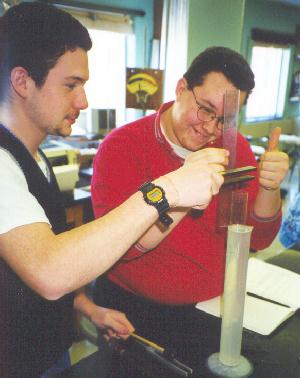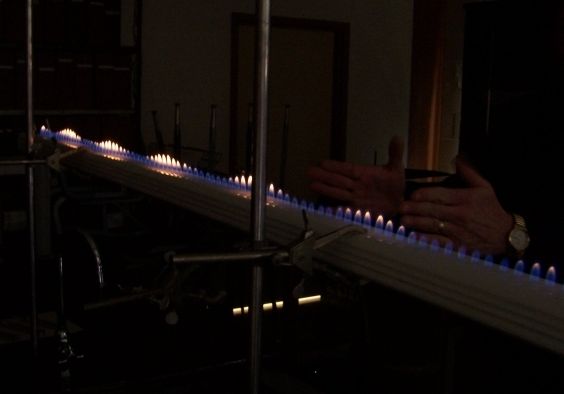Speed of Sound: Mach 1
Obj: Determine the speed of sound using resonance.
Materials: 500 mL G.C., tuning forks, resonance tube
Methods
1. Fill the 500 mL graduated
cylinder (gc) completely full. Record
the air temperature in your area.
2. Record the frequency / stamped on the tuning fork.
3. Using a vernier caliper,
record the diameter of the resonance tube.
Place the resonance tube into the gc.
4. Strike the tuning fork with
the rubber mallet, then locate the maximum amplitude (loudest volume) by
adjusting the height of the resonance tube in the gc. This will take several trials to find the exact
height above the water level.
5. Record the distance above the water
level to the top of the resonance tube.
6. Repeat for two other tuning
forks.
Analysis
(for each tuning fork)
1. Add to the distance measured
above the water level in Step 4-5 the following:
0.4 x diameter of the resonance tube.
Be careful of units. This adjusted
distance will be ¼ λ. ___________m
2. Calculate the λ and
then the speed of sound (Mach 1) for all three tuning forks. Find the average velocity.
3. Calculate a % error
using the actual speed of sound at the recorded temperature. See the Handbook of Physics.
4. How does temperature affect
the speed of sound in air? See the Handbook
of Physics.
5. If the British Airways
Concorde travels at Mach 2, how much time, in minutes, would it take to get to
downtown Buffalo, 100 km west of Brockport?
How long would it take you at Thruway speeds of 30 m/s?
6. When sound enters another
medium, such as the wall, what remains constant?
7. If sound travels at 1500
m/s in distilled water, calculate the wavelength for each of your tuning forks
in a beaker of distilled water.
Seeing Sound
Demonstration – (QuickTime movie 4.0Meg) This
demonstration must be performed only by qualified personnel. For additional
details, please contact Jim
Keefer.
Notice how the natural gas varies in color and amplitude. As the frequency
of a speaker is varied, nodes and antinodes are established along the length of
the downspout. This allows for the visual measurement of the longitudinal
wavelength of sound (seeing sound!).
Photograph and Quick Time Movie by Josh
Koelle, Physics Student March 2006

My
thanks to Dr. Robert Greenler (Physics Department at the University of
Wisconsin-Milwaukee) for the idea of seeing sound. This demonstration was
adapted from a Science
Bag presentation at UW-Milwaukee.
Back to the Brockport High School Science
Department

